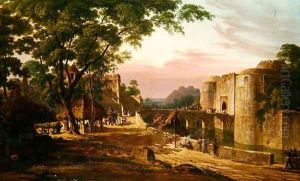Colonel Robert Smith Paintings
Colonel Robert Smith was a British military engineer and architect who is not widely known in the general annals of art history but has made significant contributions in his own right. Born in 1787, Smith had a career that spanned the fields of military engineering and architecture during the British colonial period in India.
Smith's military career began with the Bengal Engineers, a regiment of the British Indian Army that was responsible for constructing military works and buildings, as well as public engineering projects. As part of his service, Smith was involved in various campaigns and construction projects across the Indian subcontinent. His work, however, extended beyond the purely military, affecting the civil architecture of the time as well.
One of Smith's notable contributions was his involvement in the design and construction of the St. John's Church in Calcutta, which is an example of neoclassical architecture and one of the oldest churches in the city. His architectural style was indicative of the British colonial aesthetic, characterized by a mix of neoclassical elements with traditional Indian motifs, which can be seen in the church's design.
Beyond his architectural work, little is known about Smith's personal life or his broader influence on the art world. The lack of comprehensive historical records makes it difficult to assess his overall impact on the field of art history. Nevertheless, his contributions to colonial-era architecture in India represent a particular moment in the intersection of British and Indian cultural and artistic practices.
Colonel Robert Smith passed away in 1873, but his legacy can be seen in the structures he left behind, which continue to be points of historical and architectural interest. His work is a reminder of the complex layers of cultural and artistic exchange that characterized the British colonial period in India.
